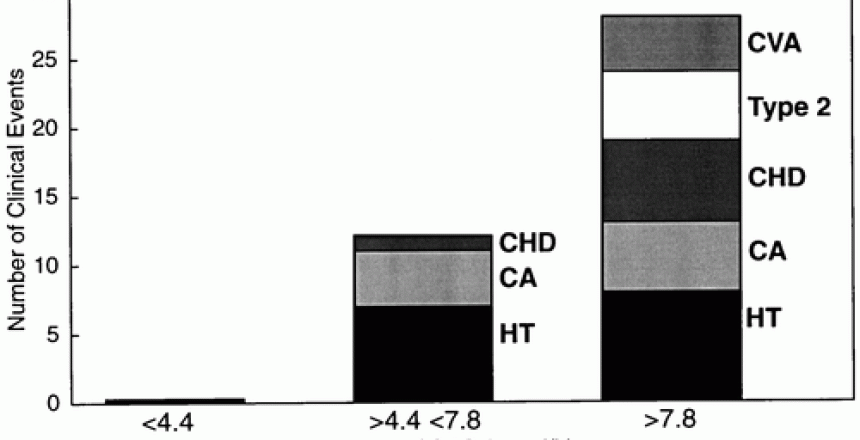Insulin resistance is bad news
Insulin resistance is a hallmark of obesity and diabetes, and occurs when cells need larger amounts of insulin than normal to take up glucose. It is also a hallmark of the couch-potato lifestyle, because lack of exercise and eating lots of refined carbohydrates, both of which characterize the couch potato, lead to insulin resistance.
Since it is so characteristic of obesity, diabetes, and being a couch potato, as well as old age, one might think that insulin resistance increases the risk of disease and is in general a bad thing, and one would be right.
Insulin sensitivity strongly protects against heart disease and cancer
Gerald Reaven, the doctor who discovered what is known as the metabolic syndrome, that is, the pre-diabetic state, along with colleagues, wanted to find out just how important insulin resistance is for health. (One of the co-authors here is Francesco Facchini, whom as we recently saw did a lot of work on the relation between iron levels and insulin resistance, and wrote a blurb for my book on iron.)
To do this, they took 208 “apparently healthy”, non-obese volunteers (98 men, 110 women), and determined their level of insulin resistance through the measurement of steady state plasma glucose (SSPG). The explanation of the SSPG is rather technical, but we’ll just note that it is not the same thing as a fasting plasma glucose. (The Journal of Clinical Endocrinology & Metabolism.)
The subjects were divided into tertiles (thirds) of insulin resistance, low, medium, and high.
They then followed the subjects for an average of 6.3 years each and looked for the “clinical endpoints” of hypertension, coronary heart disease, stroke, type 2 diabetes, or cancer. They found a total of 40 clinical endpoints in 37 of the subjects.
The shocking conclusion: ALL of them were in patients with some degree of insulin resistance. Graph below.

In the lowest tertile of insulin resistance, no one got sick. Diseases are hypertension (HT), cancer (CA) heart disease (CHD), diabetes (Type 2), and stroke (CVA).
Twenty-eight out of the total 40 clinical events were seen in 25 individuals (36%) in the most insulin-resistant tertile, with the other 12 occurring in the group with an intermediate degree of insulin resistance. Furthermore, insulin resistance was an independent predictor of all clinical events… The fact that an age-related clinical event developed in approximately 1 out of 3 healthy individuals in the upper tertile of insulin resistance at baseline, followed for an average of 6 yr, whereas no clinical events were observed in the most insulin-sensitive tertile, should serve as a strong stimulus to further efforts to define the role of insulin resistance in the genesis of age-related diseases. [My emphasis.]
Just to repeat, no one in the lowest tertile of insulin resistance developed any of the major diseases of aging and/or civilization in 6.3 years of follow-up. Insulin resistance is an independent predictor of developing one of these often fatal illnesses.
Insulin sensitivity is a key to health
We know that a low-carbohydrate diet is an anti-aging diet, and one of the ways that it slows aging is very likely by preventing the development of insulin resistance.
Exercise capacity is the strongest predictor in men of the ability to live to the age of 90. Here again, exercise strongly prevents insulin resistance, so this is probably one of the major ways that exercise helps men (and women too) live longer.
Weightlifting appears to be much better at improving insulin sensitivity than does aerobic exercise. One more, weightlifting appears to be the sovereign anti-aging exercise.
The bucket list for disease avoidance
So, what to do to prevent landing in the upper two thirds of insulin resistance and dramatically increasing your odds of getting hypertension, heart disease, cancer, and stroke?
1. Watch the carbs. If you ingest sugar in any form, whether in pastries, candy, or soda, stop. Refined carbohydrates, such as in pasta, bread, tortillas, cereal, and so on, turn into glucose after eating, so they too are implicated, and should be avoided.
2. Exercise. Lift weights a few times a week, and do some less strenuous exercise such as walking on the other days.
3. Don’t be a couch potato. Even when you’re not actively exercising, avoid being sedentary. Stand don’t sit; consider a standing desk if you work at a computer.
4. Fast intermittently. Intermittent fasting is one of the three intermittent challenges for health, and can rapidly curtail insulin resistance.














5 Comments
I commute by bicycle, lift weights a few times a week, stand all day at work, eat a healthier diet than just about anyone, and use your supplement regimen with some modifications.
Should I be concerned about the fact that I like to plop on the couch and read at night after dinner some evenings? I assume there is a threshold for when sedentary behavior starts to become harmful. Do we know what that is on a daily, weekly, or monthly basis?
David, it sounds like you’re in about the 99th percentile of fit, healthy people. There is some threshold of sitting; as I recall, some of the studies looked at increments of 2 or 4 hours or more of sitting. Obviously when we sleep we’re completely sedentary for 8 hours or more, and sleep is necessary of course. I guess what I’m trying to say is that given your lifestyle, I very much doubt that plopping on the couch in the evening is doing you any harm. I certainly do the same.
PD –
thanks for this. This got my attention: Steady State glucose, not fasting.
My fasting is routinely below 80 (so all good) and if I have a low carb or paleo meal, it stays there. However, even a smallish bit of carbs (milk sugar in coffee cream, sweet potato) it can spike to double that (yes, actually 145 mg/l) before settling down in about an hour or so.
How can I guesstimate my SSPG?
Thanks again
RM
Ross, as far as I know, one can’t guesstimate SSPG. It sounds to me like your low-carb diet has induced a degree of insulin resistance, something I’ve seen in myself as well. Basically, when you eat low carb regularly, you MUST have some insulin resistance in order to keep the liver making glucose. I’ve seen this discussed a lot on low carb/paleo forums, as people are routinely shocked when they get tested and see a high fasting blood glucose. Low-carbers also apparently routinely fail glucose tolerance tests. Is this worrisome or bad for health? It doesn’t appear to be, since if you ate more carbs for a few days, the resistance disappears. See here for a good discussion: https://www.paleohacks.com/ketogenic/the-high-blood-glucose-dilemma-on-low-carb-lc-diets-14400
Presumably, few of the people in the study ate low-carb, therefore the insulin resistance in the study is not the same as what one gets from low-carb. My understanding is that in low-carb, it’s strictly the liver that experiences a degree of insulin resistance; skeletal muscles, for example, will remain the same. In the study, the measurement of SSPG presumably measures whole-body insulin resistance.
Hi! I love how informative and great your articles are. Can you recommend any other blogs that share recipes of Paleo Bars or any other healthy snack recipes? Thanks a lot!